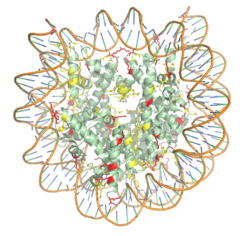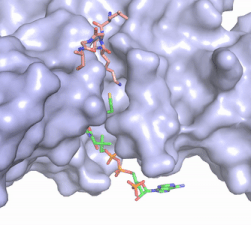Histone acetyltransferase 1-2 Complex (HAT1/2)
From Proteopedia
(Difference between revisions)
| Line 16: | Line 16: | ||
The structure of the <scene name='83/834210/Overview/2'>HAT1-HAT2 complex</scene> from the yeast ''Saccharomyces cerevisiae'' was determined by X-ray diffraction at 2.0Å resolution. The complex was crystallized in the presence of coenzyme A ([https://en.wikipedia.org/wiki/Coenzyme_A CoA]) and the histone H4 N-terminal peptide (residues 1-48). The complex has four components (HAT1, HAT2, H4 peptide, and CoA) seen with a 1:1:1:1 stoichiometry. While residues 1-48 of the yeast H4 protein were included in the crystallization, only residues 9-46 were well resolved in the refined structure. Similarly, residues 1-4 in the HAT1 subunit and residues 1-6, 87-104, and 391-401 in the HAT2 subunit were not resolved.<ref name="Yang"/> | The structure of the <scene name='83/834210/Overview/2'>HAT1-HAT2 complex</scene> from the yeast ''Saccharomyces cerevisiae'' was determined by X-ray diffraction at 2.0Å resolution. The complex was crystallized in the presence of coenzyme A ([https://en.wikipedia.org/wiki/Coenzyme_A CoA]) and the histone H4 N-terminal peptide (residues 1-48). The complex has four components (HAT1, HAT2, H4 peptide, and CoA) seen with a 1:1:1:1 stoichiometry. While residues 1-48 of the yeast H4 protein were included in the crystallization, only residues 9-46 were well resolved in the refined structure. Similarly, residues 1-4 in the HAT1 subunit and residues 1-6, 87-104, and 391-401 in the HAT2 subunit were not resolved.<ref name="Yang"/> | ||
| - | HAT1 is not catalytically active until it binds with HAT2 to form the complex.<ref name="Wu"> PMID: 22615379 </ref> The <scene name='83/834210/Hat1_-_chain_a/2'>HAT1 structure</scene> includes 317 residues and contains the binding site for acetyl-coenzyme A. <scene name='83/834210/Hat2_-_chain_b/2'>HAT2</scene> is 401 residues | + | HAT1 is not catalytically active until it binds with HAT2 to form the complex.<ref name="Wu"> PMID: 22615379 </ref> The <scene name='83/834210/Hat1_-_chain_a/2'>HAT1 structure</scene> includes 317 residues and contains the binding site for acetyl-coenzyme A. <scene name='83/834210/Hat2_-_chain_b/2'>HAT2</scene> is 401 residues and forms a beta-propeller structure with C7 symmetry. Bound to the HAT1-HAT2 complex is a <scene name='83/834210/Histone_4/3'>peptide substrate</scene> comprised of residues 9-46 of the histone protein H4. |
The HAT1 and HAT2 <scene name='81/811717/Salt_bridges/4'>interface</scene> is stabilized by multiple salt bridges, hydrogen bonds and hydrophobic van der Waals. Many of these are between a short helix spanning <scene name='83/834210/Lp1/3'>residues 200-208</scene> in HAT1 and several loops connecting β-strands in the propeller of HAT2. The HAT1 helix is important for the heterodimer formation as its deletion abolishes the ''in vitro'' interaction between HAT1 and HAT2.<ref name="Yang" /> Outside of the helix, three specific interactions at the interface involving hydrogen bonds help stabilize the complex: 1) The side chain atoms of <scene name='83/834210/Tyr199_asp308_ala202/4'>Tyr199 and Asp308</scene> with the main chain nitrogen of Ala202 in HAT1, 2) The side chain of <scene name='83/834210/Lys211phe205_and_leu288arg282/3'>Lys211 and Arg282</scene> with main chain atoms of Leu288 and Phe205 respectively, and 3) Between the side-chains of <scene name='83/834210/Serine_hydrogen_bonds/2'>Ser263 and Asp 206</scene>. Finally, the <scene name='83/834210/Hydrophobic_core/2'>hydrophobic core</scene> at the interface of the complex appears to be critical for the complex formation. This core consists of aromatic residues from HAT1 and leucine residues from HAT2, however it does not form any obvious ring stacking. | The HAT1 and HAT2 <scene name='81/811717/Salt_bridges/4'>interface</scene> is stabilized by multiple salt bridges, hydrogen bonds and hydrophobic van der Waals. Many of these are between a short helix spanning <scene name='83/834210/Lp1/3'>residues 200-208</scene> in HAT1 and several loops connecting β-strands in the propeller of HAT2. The HAT1 helix is important for the heterodimer formation as its deletion abolishes the ''in vitro'' interaction between HAT1 and HAT2.<ref name="Yang" /> Outside of the helix, three specific interactions at the interface involving hydrogen bonds help stabilize the complex: 1) The side chain atoms of <scene name='83/834210/Tyr199_asp308_ala202/4'>Tyr199 and Asp308</scene> with the main chain nitrogen of Ala202 in HAT1, 2) The side chain of <scene name='83/834210/Lys211phe205_and_leu288arg282/3'>Lys211 and Arg282</scene> with main chain atoms of Leu288 and Phe205 respectively, and 3) Between the side-chains of <scene name='83/834210/Serine_hydrogen_bonds/2'>Ser263 and Asp 206</scene>. Finally, the <scene name='83/834210/Hydrophobic_core/2'>hydrophobic core</scene> at the interface of the complex appears to be critical for the complex formation. This core consists of aromatic residues from HAT1 and leucine residues from HAT2, however it does not form any obvious ring stacking. | ||
Revision as of 16:40, 28 May 2020
The Yeast HAT1-HAT2 Histone Acetyltransferase Complex Bound to the Histone H4 substrate
| |||||||||||
Student Contributors
Morgan Buckley, Jordan Finch, Caitlin Gaich, Kiran Kaur, Emily Leiderman, Ben Nick
Proteopedia Page Contributors and Editors (what is this?)
Mark Macbeth, Angel Herraez, Michal Harel, Valentine J Klimkowski



